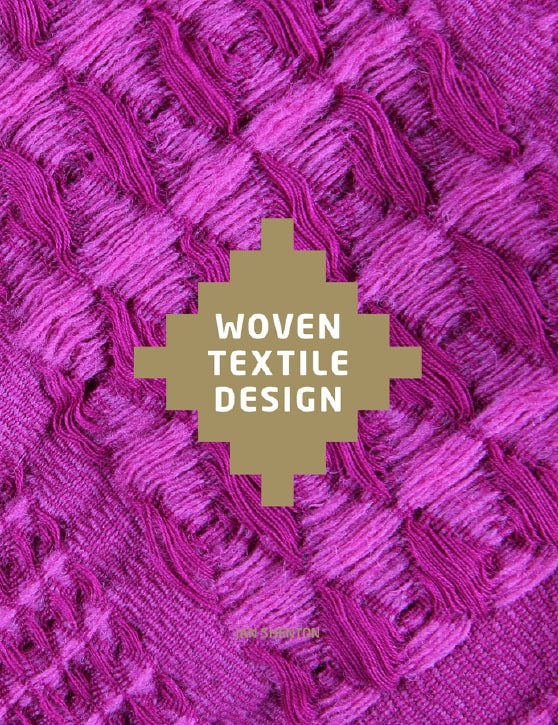by Jan Shenton

INTRODUCTION 6
CHAPTER 1:
PREPARATION FOR DESIGN 8
The loom 11
Warp information 14
The warping plan 16
Spreading the warp onto the beam 17
The threading plan 18
The reed plan 19
The lifting plan 24
The weft plan 24
Finishing details 27
Inspiration and visual research 29
CHAPTER 2:
PLAIN WEAVE 34
Plain weave on two, three and four shafts 37
Potential faults in plain weave 38
Plain-weave variations 39
CHAPTER 3:
TWILL WEAVES 44
Twills over three shafts 46
Twills using a straight draft over four shafts 50
Twills using a point draft on four shafts 54
Distorted twills 56
Combining twills 70
Satin and sateen weaves 72
CHAPTER 4:
COLOUR AND WEAVE 80
Visualizing the weave structure with colour 82
Project 1: End and end warp stripe 84
Project 2: 2 × 2 warp stripe 87
CHAPTER 5:
WARP AND WEFT DISTORTIONS 90
Grouped weft distortions 92
Grouped warp distortions 106
Single-end distortions 107
Creating a diagonal line across the weave 112
CHAPTER 6:
TEXTURED WEAVES 116
Honeycomb (waffl e weave) 118
Mock leno 124
Creating patterns with mock leno 130
Seersucker 132
Crêpe weaves 136
Corded cloths 140
CHAPTER 7:
EXTRA WARP AND WEFT PATTERNING 154
Extra-warp patterning 157
Extra-weft patterning 172
Extra warp and extra weft combined 179
CHAPTER 8:
DOUBLE CLOTH 182
Double plain interchange – warp yarns of
equal thickness 186
Double plain interchange – warp yarns of
different thickness 188
Interchanging plain-weave blocks 189
Double cloth with single-cloth weaves 192
Creating patterns using double cloth 193
Block point draft 199
Pleats 202
Pockets 215
Ribbons 216
TROUBLESHOOTING 218
GLOSSARY 219
FURTHER READING 221
INDEX 222
CREDITS AND ACKNOWLEDGEMENTS 224
INTRODUCTION
The purpose of this book is to introduce weavers to basic weave structures and inspire them to use their creative talent so they can develop their own designs and produce beautiful, original fabrics. It encourages experimentation and pushing the boundaries of what is possible. It is often while learning the craft that weavers question those boundaries, take chances and try out different yarns and colour combinations.
There is a natural tendency in novice weavers to experiment broadly, and the more knowledge and experience they have, the easier it will be for them to adapt their weaves for manufacture in the textile industry. The unconventional can be developed and translated for manufacture while still retaining some of its originality. In these pages, there are tips for identifying mistakes made in the setting-up process and during weaving, as well as simple solutions to these common problems and advice on how to make the job easier. There are defi nitions of the different terms used in weaving and explanations on how to plan and work through the more complex design processes on point paper.
The woven designs used as examples in this book have been chosen to show the designer what fantastic possibilities there are. The technical specifi cations accompanying them should help weavers translate their own ideas using their own colour palette and combinations of yarn. The woven examples will not match any of the technical details included exactly, but do show the variety available when experimenting with different yarns and structures. As a weave designer you will want to plan and produce your own original designs. Only by being the originator of an idea can you take complete ownership and have full control of the development of a project.
The mixing of colour when weaving is magical. Even with the simplest of structures, weaving is a unique way of blending colour. The use of very fi ne yarns with contrasting colours in the warp and weft means the fabric will change colour when the light catches it – sometimes the warp colour is more obvious, sometimes the weft colour is, and sometimes there is an even mix of the two. If thicker yarns in contrasting colours are used, the individual threads and colours are more visible, and if producing a single-coloured cloth, the structure used will add surface interest.
Technical knowledge and hands-on experience of setting up the loom, and of how different structures are created by actually making them, will help those going into the industry understand the manufacturing process. Some weavers will continue to produce their own collections as bespoke pieces; others will create sample designs for sale to the industry; some will work in the industry, and others will teach. The actual practice of weaving by hand is the best way to understand and to discover how to develop new ideas. Whatever your future is as a weaver, the information included in this book will help you to develop independently and creatively.
